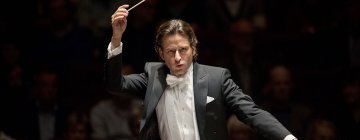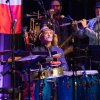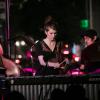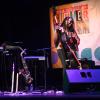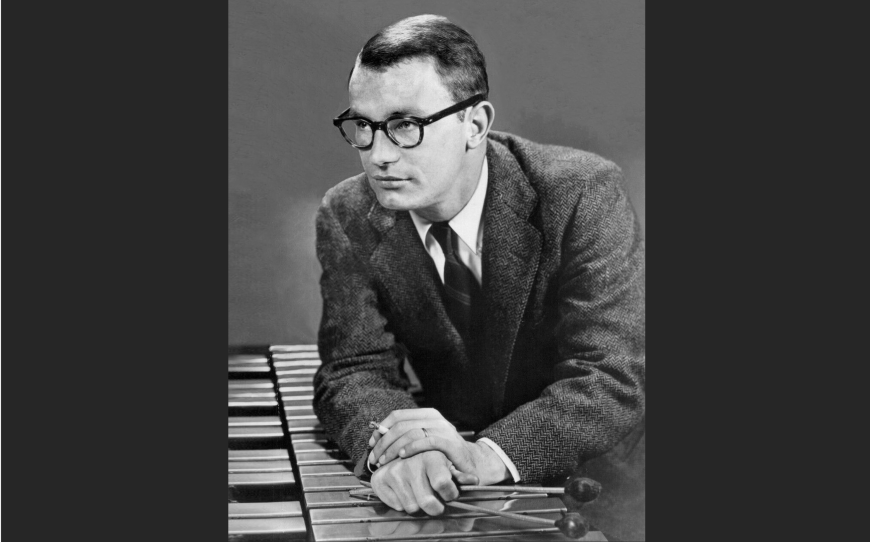
Latin jazz had no more unlikely prophet than vibraphonist Cal Tjader.
Born in St. Louis and raised in San Mateo, Tjader focused on a percussion instrument with little history in Afro-Caribbean music. He hailed from Swedish stock and had no connection to Cuba or Puerto Rico, the islands to which most of the seminal figures in Latin jazz were tied, to say nothing of Panama, Colombia, or the Dominican Republic. Yet Tjader built his career on his love of Afro-Caribbean rhythms, and his legacy continues to blaze brightly a century after his birth on July 16, 1925.
Like a Latin jazz Johnny Appleseed (or should that be Juanito Semilla de Manzana?), the vibraphonist helped sow a compelling blend of jazz and Afro-Cuban rhythms throughout the United States. He found particularly fertile soil in California, where many alumni of his band expanded on the popular sound he helped create in the mid-1950s. Some four decades after his death in 1982 at the age of 56 while on tour in the Philippines, Tjader’s influence continues to reverberate.
Though there have been numerous tributes to Tjader in the Bay Area over the years, there doesn’t seem to be a centennial celebration in the works. But in Southern California, Hollywood’s venerable Catalina Jazz Club is slated to present “Tjader at 100, Cal Tjader Centennial Celebration with Soul Sauce” on July 26. (That headlining Los Angeles-based band featuring vibraphonist Peter Burke is not to be confused with the long-running Tjader-inspired group led by Bay Area drummer Curt Moore).
Tjader’s music may not be directly present on Bay Area stages this month, but musicians he influenced are engaged in their own celebrations. Returning to the region to celebrate his 90th birthday at Yoshi’s Oakland July 25–27, East Bay-reared percussionist and bandleader Pete Escovedo came of age catching Tjader’s formative bands.
Escovedo and his brothers, percussionist Coke and bassist Phil, were enthralled by Cuban percussion greats like Mongo Santamaría and Francisco Aguabella. “And Cal was one of the first guys to mix the standard jazz songs with Latin rhythms,” Escovedo said. “He was a very good jazz vibes player, too, and the fact that he fell in love with Afro-Cuban rhythms and hired guys like Mongo, Armando [Peraza], and Willie Bobo — it was always so interesting.”
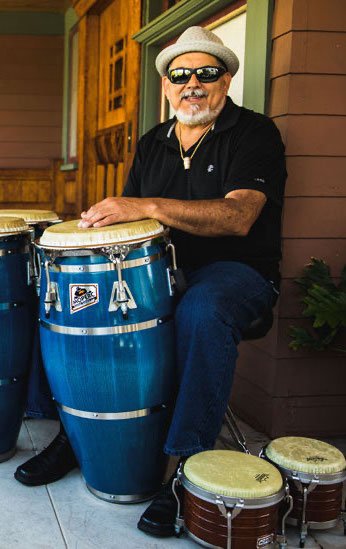
No one carried Tjader’s West Coast Latin jazz torch more faithfully than conga player Poncho Sanchez, who for the past four decades has led a popular, tireless band equally equipped to deliver soulful hard bop and dance-inducing mambo beats. He’s the first to credit Tjader as both a musical influence and a career-making talent scout. When Sanchez got his big break with Tjader in the mid-1970s, he had recently been laid off from his job working in a foundry.
“I was collecting unemployment and playing gigs on the side,” Sanchez said. “Hooking up with Cal was a dream come true. I toured the world with him for 7½ years, and I was right next to him when he died of a heart attack in the Philippines. I use the style [I learned from him] when trying to run my band. Cal was very fair, very honest. He always had paychecks ready, and there was never no horsing around. He was like my musical father, and I still miss him today.”
While Tjader is often remembered more as a bandleader than a soloist, multi-instrumentalist Roger Glenn, a fine vibraphonist himself, considers Tjader a gifted improviser who developed an individual voice on the vibes — a distinction not many others can claim. “There are very few Latin jazz vibists, and as far as Latin jazz is concerned, he created a recognizable, innovative sound,” said Glenn, who spent several years in Tjader’s band, including on the Grammy Award-winning 1980 album La Onda Va Bien. “He’s like Dizzy Gillespie in not being Latino [but] creating a band that bridged the American and Latin American communities with music.”
Glenn’s new album, My Latin Heart, draws on his experience touring and recording with Tjader, Santamaría, and Gillespie. With an instrumental bailiwick that includes an array of saxophones and flutes, Glenn is scheduled to perform at Piedmont Piano Company on Aug. 3, co-leading the project “Louis, Louis, & Louis,” a tribute to the music of Louis Jordan, Louis Prima, and Louis Armstrong. When it came to creating music with a populist touch, the low-key Tjader shared a great deal with that exuberant triumvirate.
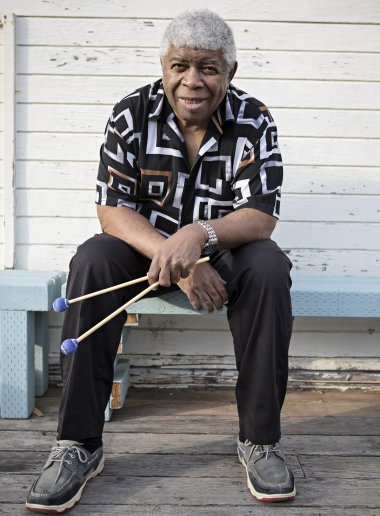
Born into a vaudeville family, Tjader grew up in San Mateo, where his father opened a dance studio. His mother, a fine pianist, started teaching her son the instrument at 2, and a year later he took up dancing, appearing in a scene in the 1936 film Too Many Parents (which also marked the acting debut of Frances Farmer). After serving in the Navy during World War II, he attended San Jose State University for a year before transferring to San Francisco State University in 1948, where he fell in with a progressive-jazz contingent that included saxophonists John Handy and Paul Desmond.
Tjader started his career as a drummer, performing with the Dave Brubeck Octet in the late 1940s, and then recorded widely with Brubeck’s much more active trio. But it was a yearlong stint playing vibes with pianist George Shearing’s popular quintet that changed Tjader’s life. The band performed frequently in New York, and Shearing’s bassist, bebop veteran Al McKibbon (a veteran of Gillespie’s pioneering Latin jazz recordings with Cuban conga player Chano Pozo), introduced Tjader to the great Latin dance orchestras of Tito Puente and Machito, sparking the vibraphonist’s lifelong love affair with Latin music.
Tjader debuted his first Latin jazz band in 1954 at the Macumba Club in San Francisco and quickly began recording a string of popular albums for Fantasy Records. He perfected his warm, spacious sound with the Bay Area label and went on to record frequently for Verve, scoring a major hit in 1965 with “Soul Sauce,” a streamlined version of the Gillespie and Pozo classic “Guachi Guara.” Tjader ended his career with Concord, launching the label’s Latin-themed Picante label with La Onda Va Bien.
Throughout his prolific career, Tjader attracted top musicians. His most celebrated band boasted McKibbon, pianist Vince Guaraldi, and the extraordinary rhythm section combo of Santamaría on congas and Nuyorican percussionist Willie Bobo — all of whom but McKibbon went on to lead their own popular bands.
Tjader kept an ear out for talented young players, though pianist Michael Wolff didn’t wait around to be discovered. The Berkeley High graduate had been working at Fantasy Studios in 1971, “and I saw Cal Tjader in a room listening to an acetate,” he recalled. “I just went in and introduced myself. ‘Mr. Tjader, I’m ready to play in your band now.’”
Tjader sized up the big-talking 19-year-old and invited him to sit in with the band at the North Beach jazz spot El Matador (the current location of Keys Jazz Bistro), which turned out to be a challenge because the underage Wolff couldn’t get in the front door. A sympathetic waitress finally smuggled him in the back, and he made an impression strong enough to earn an invitation for a two-week Tjader gig in Tucson.
“I guess he liked my playing because the next gig was a Latin jazz jam at the Monterey Jazz Festival with Dizzy Gillespie, Clark Terry, and Armando Peraza,” Wolff said. That encounter was documented on The Best of Cal Tjader: Live at the Monterey Jazz 1958–1980, which features the young pianist on a scorching 12-minute version of “Manteca.”
The album has been out of print for years, but much of Tjader’s vast discography is readily available. The music included under the umbrella of Latin jazz has morphed and expanded greatly since his death, but his joyous embrace of Afro-Cuban rhythms is no less irresistible today.
